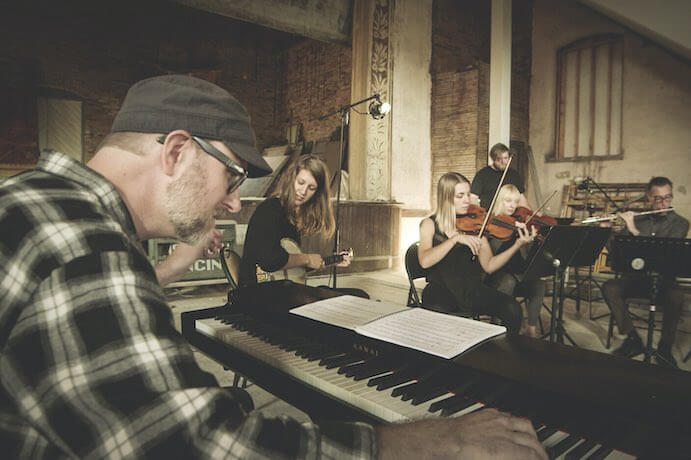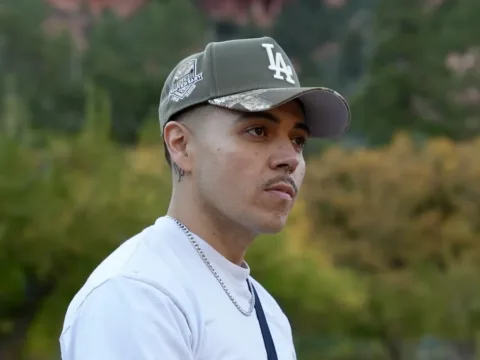Over the past 20 years, Brian Harnetty has worked extensively with sound archives to produce a wide range of interdisciplinary creative projects. Ranging from the Little Cities Archives (Shawnee, Ohio), to the Creative Audio Archives (Chicago), to the Berea Sound Archives (Kentucky), his projects create “archival performances” that invite audiences to listen closely to the subtler frequencies of creative musicians, places, and communities. His latest album, Words and Silences: From the Hermitage Tapes of Thomas Merton (2022, Winesap Records), strikes a contemplative note by remixing recordings the Cistercian monk made in solitude in Louisville, Kentucky, with newly composed music. We caught up with Harnetty to talk about his creative practice, this latest project, and his upcoming concerts.
Can you describe how you define “archival performance,” and how this concept has shaped your research, listening, and creative practices during your career?
I have a very broad definition of an archival performance: any interpretive act related to an archive. Basically, this could include any creative and critical re-imagining of archival materials into music and sound projects. But it can also mean writing, historiography, visual projects, or even the act of listening. All of these things are subjective, creative interpretations of the material. In this way, an archive becomes a kind of instrument, and to make something new from it is to perform history.
Along the same lines, I define “archives” broadly, too. Traditionally, they are thought of as top-down, bureaucratic, and connected to an institution. But I am more interested in small, community-based archives, or even a simple collection of objects.
For example, I think of my dad’s workbench — with its tools, old radios, records, typewriter parts, and organized junk — as a kind of informal, personal archive, a material reflection of his mind. When I listen to and record these objects and their static, hum, scratch, and glow, I am performing them.
For the past 20 years I’ve been working with archival materials like this, and with more formal archives, too. I work with the communities connected to these archives, from mining towns in Appalachian Ohio to the Sun Ra/El Saturn Archives in Chicago. I develop long-term relationships with community members, which help shape the music, sound art, and writing that I do.
What drew you to Thomas Merton? And what opportunities and challenges arose as you explored his recordings and archival materials for Words and Silences?
I first read Thomas Merton as a teenager. I was drawn to his solitude and silence, and to his ability to connect with different people, cultures, and contemplative practices around the world. In his late journals, I saw that a playful uncertainty and curiosity had replaced the conviction of his youth. In 2017, I decided to visit the Thomas Merton Archives in Louisville, hoping to find recordings that might reflect this openness. There, the archivist pointed me to a set of unpublished recordings Merton made in the solitude of his hermitage. Immediately, I was struck by their candor and intimacy. I immediately knew there was a sonic project there, one that could pair these recordings with new music as an archival performance.
Both a major challenge and opportunity to this type of project is time (five years went by fast!). It’s important for me to research and understand the material as best I can, and also develop relationships with people who are connected to the archival materials. In this case, the relationships include archivists and scholars, as well as meeting one of the monks who knew Merton, Brother Paul Quenon (incidentally, Brother Paul was the person who gave Merton the recorder to use in his hermitage). These relationships help remind me that the recordings in an archive are anything but abstractions; they are connected to living people today, who knew and were friends with Merton. This knowledge changes my relationship with the materials; it informs what recordings I use, and how I use them. It also informs how I write the music, and what compositional decisions I make. It is a slow and arduous process, but one built on trust, which is essential for how I work.
One thing I love about the album is the dynamic interplay between Merton’s commentary and the music. How did Merton’s use of the tape recorder as a “creative contemplative tool” for “experimental spiritual practice” inform the music on Words and Silences?
Before receiving the tape recorder, Merton had already been experimenting with poetry, painting, and photography. I admired that sense of openness and playfulness, and how he didn’t seem to mind if he made mistakes. I think he was interested in finding as many ways as he could to reveal something inside himself, and to find ways to deeply connect with the world. So, when I heard these tapes, they felt like a natural extension of that practice, now focused on a new medium.
In Words and Silences, I let this openness inform the project. I began with careful, close, and repeated listening to Merton’s recordings, as well as the music he loved throughout his life. I then made transcriptions of both the tapes and music. This became the sonic material that I worked with. I also paid attention to additional information on the tapes — sounds of a ticking clock, birds, or the pacing and emotion in Merton’s voice — as glimmers and clues of how to make the music complement the words. I created a sonic space for Merton’s voice to inhabit; a relatively static world that interacts with the words but also gets out of the way to let Merton’s emotions and curiosity remain in the forefront.

The rich essays that accompany the album outline several tensions you experienced during the composition process. Why was it important to share these struggles, such as composing in solitude, or deciding whether to use some of Merton’s recordings?
I can explore things in writing that I can’t (or don’t want to) in music. I like interdisciplinary projects, and how the lenses of music, writing, video, and sound can inform a project from different perspectives. Here, the writing process was less about analysis, and more focused on documenting my process of working with the tapes. It’s not easy to write about sound! So, I set out to describe the sounds as best I could, and also describe how they affected me. I used the ethnographic writing skills that I’ve developed for research and applied them to my own process and work.
Merton’s recordings are very rich and complex, and like his writing, they can stand on their own. I wanted my approach to this material to strike a balance between offering context for his words, but also to avoid being too didactic or dogmatic. I’m more interested in opening up and letting go, instead of defining and boxing in. Both the music and the essay allowed me to do this in different ways. For example, in “Who Is This I?” the music helps reveal the deep emotion present in Merton’s wavering voice. And then in the essay I was able to offer context around this moment, as part of understanding Merton’s innermost voice and uncertain self. These different approaches allowed me to explore the tension between Merton’s fluency as a writer — where it feels so sure of itself — and the human, affective, and vulnerable qualities of the recordings.
This multi-faceted project also includes live performances, including one at Ohio State University’s Wexner Center for the Arts on November 9. Why is presenting the album “live” an important part of an archival performance project?
I see a live performance as a way to bring archival materials out from the basement and into the world. It is a way to give the recordings a new life and context. I also see archival recordings as gifts. Much like oral histories or folk tunes, their power lies in their exchange and retelling, which is bound up with my own subjective interpretation and also an archival stewardship. I’m a fan of the author Lewis Hyde, who talks of the “gift economy,” where the sharing of gifts is not transactional, but relational. It’s this circulation and movement that I’m after in a live performance.
Another important aspect to my work is having a strong connection to place. For Words and Silences, it is a sense of Merton’s hermitage in rural Kentucky. For the performance at the Wexner Center, we are including long, contemplative video shots of the hermitage, to help the audience get a sense of how Merton lived there. To my mind, the place becomes an integral part of the project.
This summer, I traveled to the hermitage to record a solo performance. While performing on Merton’s front porch, a storm came in. Everything became dark, and the sound of wind in the trees took over the recording. It really felt like I was interacting with the place! It was such a profound experience that I decided to bring the entire ensemble down with me to the hermitage in November to film and perform inside. The hermitage’s acoustics and environmental sounds — which are already present in the Merton tapes — will also become a part of the performance. And again, performing at the Hermitage also completes the circle of the gift exchange, as we can return the project to where it began, and share it with people who knew Merton personally.
I CARE IF YOU LISTEN is an editorially-independent program of the American Composers Forum, and is made possible thanks to generous donor and institutional support. Opinions expressed are solely those of the author and may not represent the views of ICIYL or ACF.
You can support the work of ICIYL with a tax-deductible gift to ACF. For more on ACF, visit the “At ACF” section or composersforum.org.
























